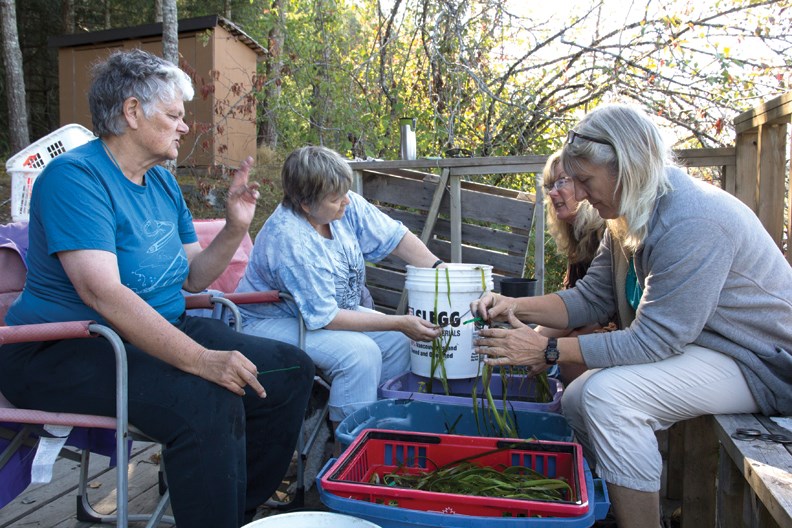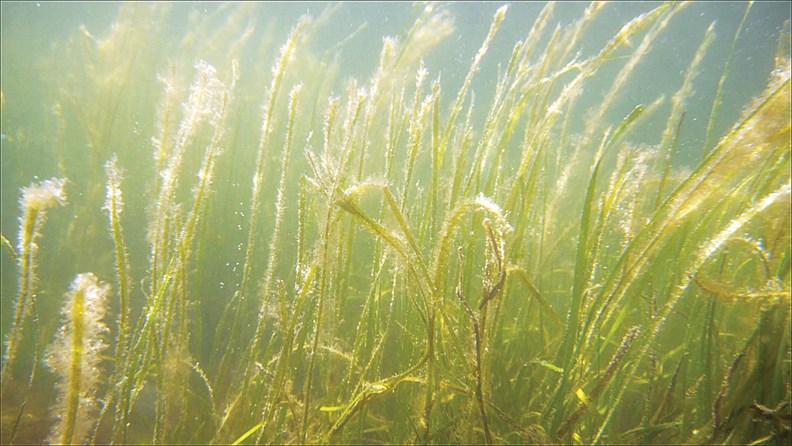A team of eelgrass conservationists is on the Sunshine Coast as part of an ongoing project to reinvigorate eelgrass beds. This sensitive plant is under threat from human development.
“The eelgrass beds here have been fragmented in some places,” Sunshine Coast resident Dianne Sanford, one of the directors of the Seagrass Conservation Working Group (SCWG), said. “Basically what we’re doing is trying to supplement those gaps so that we have the continuous beds that used to exist here historically.”
Sanford is working with Nikki Wright from Saanich Inlet, the founder of the project, who was on the Coast with the dive team that plants eelgrass shoots.
The SCWG team spent last Monday and Tuesday monitoring the existing eelgrass sites that they have been working with, as well as searching for new ones.
Over Wednesday and Thursday the team planted shoots harvested from donor beds that were weighted with washers by volunteers from the Sunshine Coast Friends of Forage Fish group.
Their hope is that the eelgrass will take root and spread out along the seafloor. Eelgrass grows similarly to bamboo, with one main root system that networks out just below ground level and sends up multiple shoots.
Eelgrass is extremely photosynthetic and any structure that shades it – a dock, for example – is harmful. Sanford said that boat anchors are a significant problem because they drag through the eelgrass, ripping it off of the sea floor.
“You end up with a fragmented bed, and a fragmented bed is a weaker bed. What you want is a continuous meadow,” Sanford said.
Five eelgrass sites around the Sunshine Coast have been identified for rehabilitation. Wright said that they check in with them about every two years to see how things are progressing.
“The very best one is right in [East Porpoise Bay],” Wright said. “Now we have 100 per cent cover here."

There was an attempt to rehabilitate a site in Halfmoon Bay a few years ago, but it proved unsuccessful. According to Wright, it’s going to be used for research.
“We’ll have different sites with different levels of recovery,” Wright said. “That one will be showing it still at the very beginning stages of recovery. The log debris and the wood waste is quite large. Whereas in places like Sechelt Inlet the fibre has degraded to such a point that the eelgrass is starting to grow back well.”
Eelgrass is not endangered, but it is a delicate part of the ecosystem that links fresh water to seawater. Many species rely on it for a variety of reasons: cover from predators, as a nursery and as a migration route.
Salmon rely on eelgrass for protection and a food source during their transition out of the streams and into the ocean.
“It’s where they learn how to eat seafood,” Sanford said. “They have shelter and they have a migration corridor because [eelgrass] grows parallel to the shoreline in a lot of places.”
Due to human development along coastlines, the corridor of eelgrass has been broken up in many places, especially in areas used as chutes in the early logging days.
Sanford explained that eelgrass typically grows just outside of estuaries where sediments and nutrients are carried downstream from forests.
“With the eelgrass there, it’s stabilizing the substrate and it’s also providing a place for all that sea life to come and wait for the food to arrive,” Sanford said. “You have this continuum going on, a constant cycle.”
Wright said that out of 18 eelgrass sites she has worked on, Sechelt Inlet is the most promising because it still has integrity as an ecosystem, despite the impact of human development.
“This area, if precaution is taken – if awareness is imparted – it still has the capacity to have an entire intact, healthy ecosystem,” Wright said.
“That system provides oxygen for our world, a carbon sink, and the vitality that makes the Inlet what it is,” Sanford added.
Wright said that in Saanich Inlet, where she lives, the human impact has already taken too much of a toll on the ecosystem.
“The fisheries have collapsed, the lingcod have collapsed, the crab fishery is failing, the [harvest] of shellfish is closed,” Wright said. “They may still be there but they can’t be harvested.”
There is a large network in B.C. of scientists, conservation groups and First Nations who are all concerned with eelgrass. Wright said they have been working together since 2001 to share information and resources.
“It’s that network of conservationists from Haida Gwaii down to Boundary Bay that makes this work possible,” Wright said.
Most of the funding for SCWG comes from the Pacific Salmon Foundation and the National Wetlands Conservation Plan. Local funding has assisted with mapping Sunshine Coast eelgrass beds to provide information to planners, developers, and shoreline homeowners. Wright said that there are also exceptional time contributions from volunteer labour and the use of equipment.



